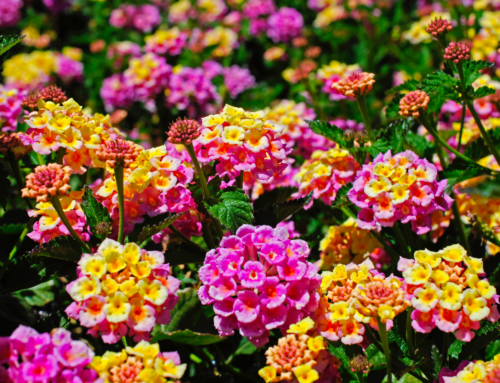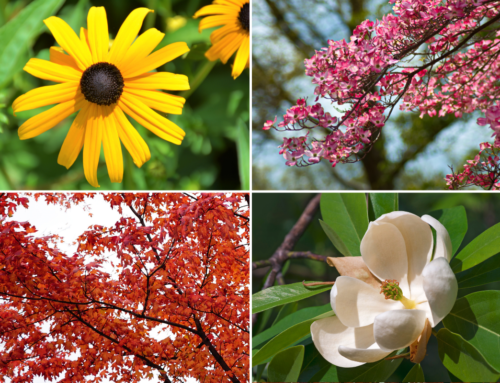Crocus are perennial spring flowering bulbs that scream “Spring is almost here!” here in Middle Tennessee.
They grow beautifully in zones 4 to 10 and produce wineglass-shaped flowers in so many color combinations of purple, white, yellow and even striped, it’s hard to decide which color and variety to grow.
There are about 30 different species that are available on the market today. The most common ones are the Giant Dutch Crocuses, Crocus chrysanthus, Crocus sieberi, and Crocus tommasinianus.
Below is a brief description of each of these.
Giant Dutch Is the largest type of crocus. By the word “large” in the crocus world, it means only about 4 – 6 inches (10-15 cm) tall.
This variety is one of the most popular varieties to plant in large numbers, or drifts , and in containers, rock gardens, under trees and shrubs, in lawns or perennial beds. Great for zones 4-8
Common names for these that you may find in catalogs are ‘Jeanne d’Arc’ (white),‘ King of the Striped’( a gorgeous purple striped which dates back to the 1880’s)‘Golden Yellow Giant’(sunshine yellow).
Crocus chrysanthus Smaller than the Giant Dutch, this is considered a snow crocus (which is all crocuses besides the Dutch Crocus). It comes in colors of white, yellow, mauve, purple and blue and blooms about two weeks sooner than the Giant Dutch.
You will most likely easily find “Cream Beauty” with it’s creamy yellow flowers at your local garden center. These are perfect for rock gardens, sunny borders, grass, but may also be grown in pots for blooming indoors.
Mail-order catalogs and online sources will have a greater variety such as ‘Prince Claus’ (white with deep purple on the outer sides), or even a ‘Tricolor Specie’
Crocus sieberi is another Snow Crocus that blooms very early. It’s easy to naturalize (meaning it comes back every year and multiplies), grows to about 3 or 4 inches, and comes in shades of blue, mauve, and purple. Look for names like ‘Firefly’ (lilac), and ‘Violet Queen’ (light purple).
Crocus tommasinianus – These also naturalize well, bloom early, and come in colors blue, mauve and purple. Look for names like ‘‘Crocus tommasinianus’ ( lavender), ‘Albus’ (creamy white), and ‘Rudy Giant’ (deep reddish solid purple)
Where to Plant Crocus
These lovely little bulbs are in the iris family and grow from corms in a variety of habitats including woodlands and meadows. They are perfect for rock gardens or in the front of perennial beds.
Planting them next to hellebores , also called Lenten rose, which also bloom early, makes a striking late winter/early spring planting.
They are easy to grow in well drained soil and love being out in the open.
They also do well under light shade of deciduous trees and shrubs. When selecting a site, look for a minimum of five to six hours of sunlight a day.
If you like, you may even plant them in a grassy area since they die back just about the time mowing season starts.
Since this bulb blooms when the weather is cool and when you are less likely to be out in your garden, we recommend planting them near a parking area or near the front of your home. Wherever you and your guest will see them easily.
You’ll love seeing them bloom and even thriving peeking-up through the snow.
Tips For Growing Crocus in the Mid South
Buy firm dormant bulbs in late summer or early autumn. Ordering from mail-order companies early in the season allows you to find the best choices at the best price. Be sure to check your bulbs when they arrive. If they have mold, unpleasant odor, a soft feel, or blemished in any way, contact the supplier immediately.
Plant about 3 to 4 inches deep and about the same distance apart. For a naturalized look, plant in drifts with 50 to 100 or more bulbs in one area.
After planting, cover bulbs with soil. Water well and mulch with composted leaves or shredded pine bark. This not only conserves soil moisture, but keeps mud from splashing up on the tiny flowers as they are blooming.
Once bulbs appear in the spring, fertilize with a natural bulb food such as a Bulb Alive! to ensure vibrant, healthy bulbs.
If your site has poor drainage, drain pipes can be laid to help remove excess water. If this isn’t a good option, add organic matter to a heavy clay soil.
Our local extension service recommends adding 30 percent organic matter by volume by spreading a 4 inch thick layer over the bed and tilling it into the soil to a depth of 12 inches.
This will also help sandy soil which drains too quickly.
Since many bulbs set seeds quickly, deadhead once flowers are spent by cutting the flower stalk off at the base and leave the foliage.


